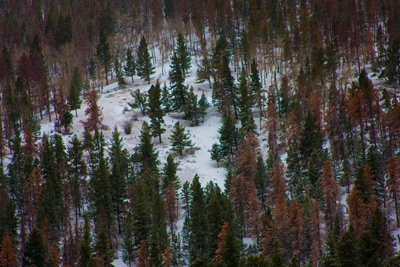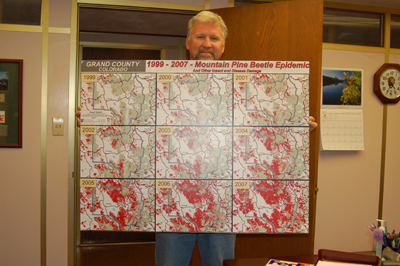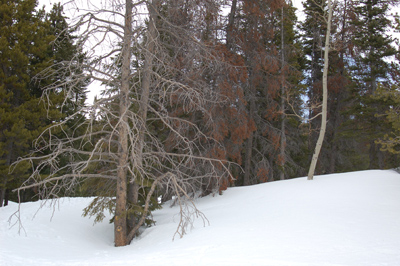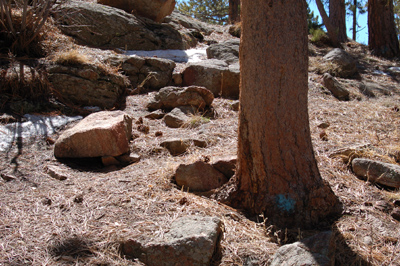
Pine beetle problem part of natural process
ESTES PARK, Colo. — In a national park that has the reputation of having some of the most magnificent forests in the country, trees have been dying at an alarming rate the last 10 years. And the problem is no larger than a grain of rice.
“There are entire mountains where the side is just brown,” said Don Bowen, part-time resident of Estes Park throughout his life and a full-time resident since 1997.
The culprit? Swarms of mountain pine beetles that have moved into the park primarily after droughts in 2002 and 2003.
| Areas where the trees have mostly been killed by mountain pine beetles can be found throughout the park (Photo by Lori Koutrokois). |  |
Mountain pine beetles have been around for thousands of years and are nothing new to forests. They can be found as far north as British Columbia and as far south as Mexico.
“This is not just a local Colorado phenomenon,” explained Dr. Monique Rocca, a professor and ecologist at Colorado State University in nearby Fort Collins who studies forest fires as well as the effects that the mountain pine beetles have on the park. “BC has been hit really hard, and other areas of the Rockies have also been affected.”
The mountain pine beetles were first thought to have moved into Rocky Mountain National Park as a result of global warming since the temperatures in the winter were not as low as they once were, making it easier for the beetles to survive. However, the theory has shifted and now it is believed that extended periods with limited amounts of water weaken trees’ defenses against the beetles and make them more susceptible to an attack.
Even though the mountain pine beetle is relatively new to the park and is causing many of the trees to die, they are looked at as a “natural” occurrence and are not considered to be an invasive species.
 |
Mark Magnuson, chief ranger at Rocky Mountain National Park, holds a graphic that shows the spread of mountain pine beetles in Grand County from 1999 to 2007 (Photo by Bolton Lancaster). |
The beetles use trees, primarily lodgepole, ponderosa and lumber pines, as a place to plant their eggs. In late summer, female beetles seek out new trees where they can burrow underneath the bark, attract a mate by releasing pheromones, and eventually lay eggs inside the tree, using it as a place to stay warm during the cold months of the year.
However, the trees are not defenseless. They attempt to “pitch out” the beetles by releasing sap in areas where the beetles have started to burrow through the bark. The sap forces the beetles out of the tree and sometimes completely traps them. When beetles make the move to new trees, they attempt to shut down this defense system.
“Once the mountain pine beetle gets into the tree, it releases a blue fungus that wraps itself around the flow system,” said Sandy Osterman, a volunteer at Rocky Mountain National Park.
The blue stain fungus is comparable to cholesterol in humans: it prevents the tree from absorbing and circulating the nutrients that they need to survive. This ultimately kills the tree and allows for easy invasion by the beetles.
The effects that the mountain pine beetle has had on the park are debatable. It was widely believed that the increased number of dead trees made the park much more susceptible to fires, but this belief is fading as recent studies show that there is only a one-year period where the dead trees are in a “red” phase (the color of the pine needles on the tree) where they add to the fuel load of the park. After that, the dead trees enter into a “gray” phase, where the chances of catching on fire are slimmer.
| Trees at Bear Lake go through a “red” phase (middle ground) followed by a “gray” phase (foreground) after being infested and killed by mountain pine beetles. While in the one-year “red phase,” it is believed that trees are more susceptible to forest fires (Photo by Bolton Lancaster). |  |
“Fires occur with or without beetles,” Rocca said.
Experts believe that the risk of forest fires due to the mountain pine beetle may be over-exaggerated in the past and now look to bring light to the myth.
However, the trees dying as a result of beetle infestations have potential to affect all of the wildlife in the park.
“If the ponderosa pine were to be wiped out, it would have a cascading effect on the ecosystem,” said Cynthia Langguth, a Rocky Mountain National Park ranger.
The park is attempting to protect the trees by using both carbonyl sprays and pheromone packets. The carbonyl spray repels the beetles and are used on “high-risk” trees, which are located in frequently visited areas of the park and could harm visitors if they fell over after being killed by beetles. These trees are sprayed for safety reasons as well as to preserve the beauty of the park.
The pheromone packets, which give off pheromones that trick the beetles into believing that a healthy tree is already inhabited, are used in the backcountry primarily on lumber pines in hopes of protecting specific ecosystems. While the park works hard to minimize the effect of the mountain pine beetle, most of the trees are not treated at all simply because it is such a large-scale problem.
“It’s nothing you can really stop,” said Mark Magnuson, chief ranger at the park. “It’s just a force of nature that you really can’t do much about.”
 |
A “high-risk” tree in Moraine Park Campground is sprayed with blue paint at the base to indicate that it is to be sprayed with carbonyl to repel the mountain pine beetles. Such trees are located in frequently visited areas where people could be harmed if the tree fell over after being killed by the beetles (Photo by Bolton Lancaster). |
The mountain pine beetles have affected more than just the trees in the park, as the residents of surrounding cities are encouraged to take down infected trees on their property before eggs hatch in the summer. The drastic change in the park has affected local markets as well as the natural beauty of the area.
“The national park is our biggest draw,” Bowen said. “People come to Estes Park to go through the park.”
In a town that relies heavily on tourism, especially in the summer, decreased traffic to and from campsites can lead to heavy losses for small shops in the area.
Rangers, nearby residents and tourists all cannot help but wonder what is to become of the park.
“The prognosis, so to speak, is that the forest will come back and regenerate itself, becoming more diverse,” Magnuson said, although he admitted that it would be a timely process. “Nature has a way of recovering.”
Rocca is also confident that the forests will be able to recover on their own and that suriving trees are continuing to grow.
“There is no need to plant trees,” she said. “At least 80 percent of the forest has enough new seedlings to grow back.”
The mountain pine beetles primarily look to infest larger trees, such as lodgepole pines. Smaller trees will eventually be more common throughout the park not only because they are targeted less by the beetles, but also because they cannot grow when lodgepole pines block their access to sunlight and use all of the nutrients in the soil.
The problem posed by the mountain pine beetle in Rocky Mountain National Park can be looked at as a natural phenomenon that human intervention cannot solve but will work itself out over time. Now, the only thing to do is to wait.
“I think it’s a challenge for communities who live here to see the forest die around you,” Magnuson said. “Over time, people begin to accept that it’s part of a natural cycle.”
If You Go
Rocky Mountain National Park is open 24 hours a day year round.
Entrance fees are $20 for cars and $10 for cyclists, both of which are valid for seven consecutive days.
Directions:
- From Denver and the east— Take U.S. 34 from Loveland or U.S. 36 from Boulder to get to Estes Park.
- From Denver International Airport— Take Pena Boulevard to Interstate 70 west. Continue on Interstate 70 west until it intersects with Interstate 25 north. Take Interstate 25 north to exit number 243, which is Colorado Highway 66. Go west on Highway 66 for about 16 miles to the town of Lyons. At the first stoplight, continue going west and Highway 66 will merge onto U.S. Highway 36. Continue another 22 miles to get to Estes Park.
- From the west and the south— Take Interstate 70 to U.S. 40 between Georgetown and Idaho Springs. Then, take U.S. 74 in Granby through Grand Lake.
Note: The park is drastically different in the winter than it is in the summer as there is a lot more snow throughout the winter months. Winter activities include snowshoeing and sledding while summer activities usually focus on hiking. Trail Ridge Road, which connects the east and west sides of the park, is closed during the winter.

Comments are Closed